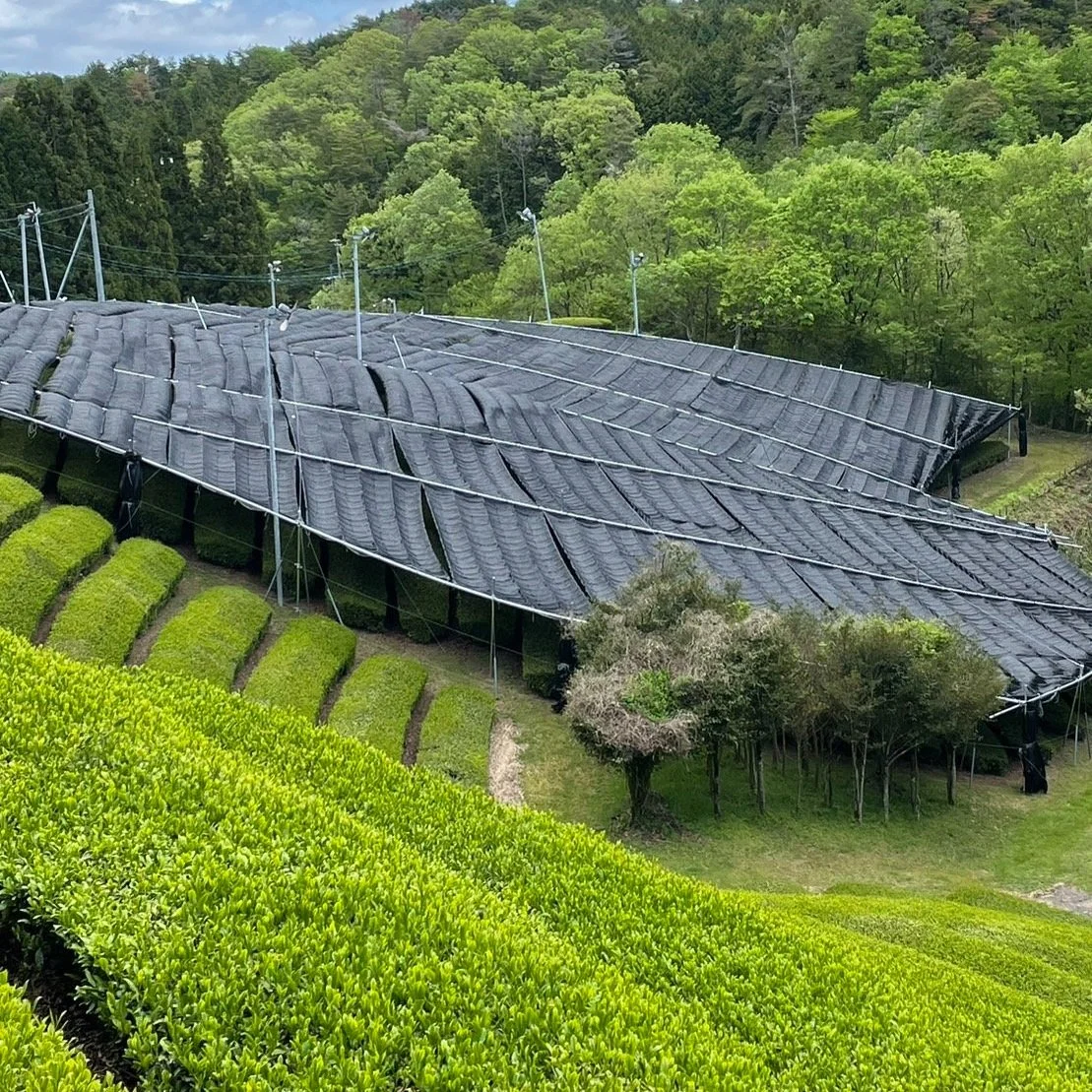Die Herstellung von Matcha - Beschattung und Verarbeitung
Der original japanische Matcha verdankt seine gesundheitliche Wirkung und seinen einzigartigen Geschmack dem speziellen Herstellungsprozess. Doch wie genau funktioniert das mit dem gemahlenen Grüntee? Wir klären euch auf.
Schritt 1 - ganz normaler grüner Tee
Schritt 1 - ganz normaler grüner Tee
Sencha oder Matcha? Zu diesem Zeitpunkt ist noch alles möglich.
Matcha ist ein unfermentierter und gedämpfter grüner Tee aus der Teepflanze “Camellia Sinensis”. Bis wenige Wochen vor der Ernte ist Matcha “ganz normaler grüner Tee” aus Japan. Zu diesem Zeitpunkt könnte aus dem Tee auch Sencha, loser japanischer Blättertee, werden. Erst die Herstellungsprozesse danach machen aus dem normalen Grüntee ein komplett anderes Teeprodukt.
Schritt 2 - Die Beschattung
Wenige Wochen vor der Ernte werden die Teepflanzen mit Planen abgedeckt. Wann genau, entscheidet der Teebauer jedes Jahr nach seiner Erfahrung. Eine immer gleiche Anzahl an Wochen der Beschattung gibt es daher wie oft behauptet nicht. Die Pflanzen werden so vor Sonnenlicht abgeschirmt. Dies hat gleich mehrere Effekte. Das Teeblatt wird größer und breiter, um das wenige Sonnenlicht einzufangen. Der Anteil des Pflanzenfarbstoffs Chlorophyll steigt an. Dies macht die tiefgrüne Farbe des Matchas aus. Aminosäuren, die für den süßlichen Geschmack zuständig sind, werden angereichert. Gleichzeitig werden weniger Bitterstoffe gebildet. Die brauch die Pflanze nämlich normalerweise zum Schutz vor starker Sonneneinstrahlung.
Zu diesem Zeitpunkt könnte man aus den Teepflanzen auch noch Gyokuro (玉露) herstellen. Denn auch wie Matcha, wird der teuerste japanische Blättertee vor der Ernte beschattet. Erst mit der Weiterverarbeitung wird der Matcha wirklich einzigartig.
Die Teefelder von Masahiro San in Uji werden mit dunklen Planen abgedeckt und so vor dem Sonnenlicht geschützt.
Schritt 3 - Die Ernte
Viele der Teepflücker sind weit über 70 und eigentlich bereits pensioniert.
Viele der Teebauern setzen bei der Ernte weiterhin auf das Pflücken mit handgeführten Maschinen oder ganz selten noch auf das Pflücken per Hand. Oftmals sind auch die Teefelder so unzugänglich gelegen, dass die Ernte mit Maschinen gar keinen Sinn machen würde. Da wir unseren Matcha nur von einzelnen Teebauern aus den bergigen Regionen der Präfekturen Shizuoka und Kyoto (Uji) beziehen, wird SHO CHA Matcha nur per Hand oder Handmaschine geerntet. Dies ist zum Vorteil der Qualität, denn es werden lediglich die obersten beiden Blätter und die Knospe dazwischen geerntet. Hier kann das geschulte Auge der Teepflücker ganz genau erkennen, ob das Teeblatt die notwendige Qualität hat.
Inzwischen werden bei der Teeernte in Japan oft auch bereits pensionierte Helfer eingesetzt - die sogenannten Silver Worker. Die Teebauern profitieren von der Erfahrung dieser Helfer und die älteren Menschen freuen sich über eine Aufgabe, die sie im Alter fit hält sowie einen kleinen Zuverdienst. Unser Matcha N°1 aus Shizuoka wird bspw. ausschließlich von dem Teebauern Hasegawa San und seinem pensionierten Vater angebaut, geerntet und verarbeitet.
Schritt 4 - Bedampfung und Trocknung
Die frisch gepflückten Teeblätter werden sofort bedampft. Dies stoppt die Fermentation. Der Tee behält damit seine tiefgrüne Farbe und mit ihr all die gesunden Inhaltsstoffe. Der Tee wird danach belüftet. Dies kann man sich quasi wie einen riesigen Fön vorstellen, der die Blätter trocken fönt. So wird Feuchtigkeit, die dem Tee schaden könnte, beseitigt. Danach werden die Teeblätter grob zerdrückt. Dies macht den nächsten Schritt des Herstellungsprozesses einfacher. In diesem Stadium wird der Tee übrigens Tencha (碾茶) genannt.
Schritt 5 - Mahlen
Der Matcha wird nun für den Mahlvorgang vorbereitet. Die Stängel und Blattrippen der Teeblätter werden entfernt. Nur das Blattfleisch wird vermahlen. Ca. 1/10 des ursprünglichen Blattgewichts bleibt dabei übrig. Matcha wird auf Granitmühlen verarbeitet. Dabei geschieht dies jedoch nicht wie früher per Hand. Moderne Maschinen übernehmen den Großteil der Arbeit. Dennoch wird bei gutem Matcha, wie auch bei unseren Matcha Tees, nach wie vor Granitstein als Grundlage für das Mahlen verwendet. Dies dauert zwar länger, ca. eine(!) Stunde für 40g Matcha, aber produziert gleichzeitig ein ultrafeines Pulver in höchstmöglicher Qualität. Nur so kann der Matcha zum Genuss einfach aufgeschäumt werden.
Fazit: Ohne Erfahrung geht es nicht
Matcha wird seit ca. 800 Jahren in Japan hergestellt. Dabei umfasst der Anbau und die Verarbeitung viele entscheidende Handgriffe. Nur die von Generation zu Generation weitergegebene Erfahrung, die Sorgfalt und Handfertigkeit der Teebauern garantiert einen gesunden und leckeren Matchagenuss. Genau deshalb importieren wir bei SHO CHA ausschließlich japanischen Matcha direkt von engagierten Teebauern aus den Präfekturen Shizuoka und Kyoto. Matcha aus Kagoshima oder allgemein von der Insel Kyushu wirst du bei uns nicht finden. Dort hat nämlich der Anbau und die Verarbeitung von Matcha keine lange Tradition.
Du möchtest mehr über unsere Teebauern erfahren oder gleich einen authentischen Matcha probieren? Dann schau direkt bei unseren Matcha Tees vorbei. Auf jeder Produktseite findest du zahlreiche Infos & Bilder zu dem Teebauer, der den jeweiligen Matcha Tee produziert hat.




